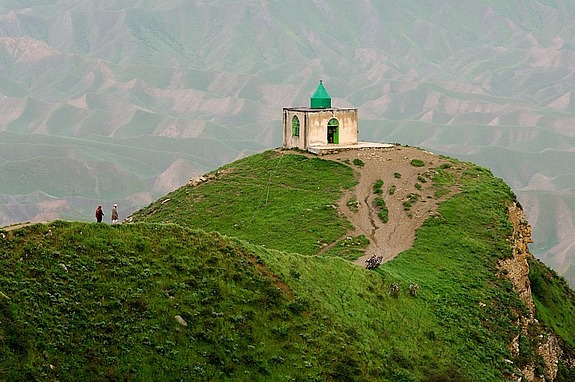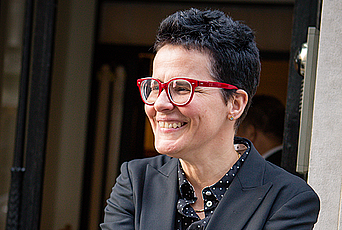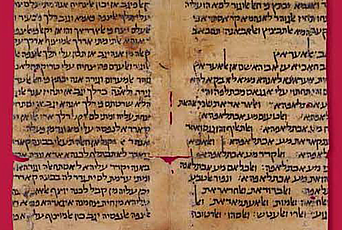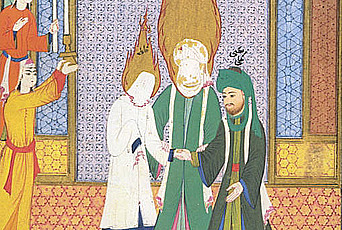Patricia Crone’s Contribution to Iranian Studies

In the preface to her last book, The Nativist Prophets of Early Islamic Iran,1 the late IAS Professor Patricia Crone (1945–2015) relates when and how she became interested in Iranian Studies. It was early on during her time at Oxford that her colleague John Gurney suggested that she “teach a course on the transition from pre-Islamic to early Islamic Iran.” Crone took up the challenge and devised a course, which she continued teaching and constantly refining over the thirteen years she spent at Oxford. Over the decades, her immersion into things Iranian resulted in a steady flow of groundbreaking publications on a large variety of aspects of religion, law, and political thought in pre-Islamic Iran and early Islamic Iran, as well as the transition from pre-Islamic to early Islamic Iran.
The transmission of Iranian notions into Islamic culture as such is a prominent field of research, and scholars, including Patricia Crone, have studied this phenomenon intensively from a variety of angles, starting as a rule with the rise of the ʿAbbāsids to power and, specifically, the time of the caliph al-Maʾmūn (r. 813–833).
A first approach, which is widely represented in modern scholarship, is to investigate issues such as the process of conversion of the people of Iran to Islam and the relation between the ʿAbbāsid revolution with its Persian origins, on the one hand, and the Iranians, as well as the Shīʿites, on the other. Although this was not the principal occupation of Patricia Crone’s work, she did contribute to this field as well, for example, with her studies on the mawālī, which include her 1974 Ph.D. dissertation, “The Mawālī in the Umayyad Period,” and her 2005 study “Mawālī and the Prophet’s Family: An Early Shīʿite View,” and with her studies on the ʿAbbāsids, such as her study of 1989 “On the Meaning of the ٴAbbāsid Call to al-Ridā.”
A second approach focuses on the political and administrative institutions and practices that originated in the earlier Sasanian tradition of Iran and were gradually adopted by the new Islamic empire. While the Umayyads strove to suppress Iranian administrative concepts by replacing them with their own Arab notions, Iranian notions again became very important under the ʿAbbāsids when members of the Iranian local elites, such as the Banū Barmak or the Banū Sahl, rose to power in the new imperial administration by serving, for example, as “ministers”—wuzarāʾ (wazīr originally being a Middle Persian word)—to the ʿAbbāsid government. They were thus in the position to put into practice Iranian administrative and political ideals and to have relevant works translated from Pahlavi Middle Persian into Arabic.
Political notions of Sasanid Iran also informed some of the later Iranian dynasties who employed them to legitimize their autonomy vis-à-vis the ʿAbbāsid caliphate—this was the case with the Ṭāhirids in the ninth century, as well as subsequent Iranian dynasties ruling over Khurāsān and Sistān, the Ṣaffārids and the Sāmānids, during the ninth and tenth centuries. It was also during the Ghaznavid period (tenth and eleventh centuries) that Firdawsī (d. 1020) composed his renowned Persian epic poem Shāhnāmeh, in which he praises Sasanian emperors and criticizes the Arab conquests. Although other Persian texts had been written before Firdawsī’s time, it was the Shāhnāmeh in particular that encouraged other Iranians to write in Persian, which soon re-emerged as a language of culture. The Shāhnāmeh became a symbol for the Iranians’ desire to return to their ancient roots—the famous scholar Ḍiyāʾ al-Dīn Ibn al-Athīr (d. 1240) considered the work as the “Qurʾān of the Persians” (Qurʾān al-ʿajam).
In her 2004 book, titled Medieval Islamic Political Thought, Patricia Crone investigates in detail the strategies the respective Iranian rulers employed to articulate their independence from the caliph. The Shīʿī Iranian dynasty of the Būyids (tenth and eleventh centuries) went even further in that they not only established their own government in Iran, but also conquered Baghdad and dethroned some of the ʿAbbāsid caliphs as they saw fit. Ideologically, they systematically integrated Iranian political notions into their ideological framework and political language.
A third approach in modern scholarship addresses the origins and subsequent development of Iranian political thought, such as political etiquette and, especially, the literary genre of the “mirror for princes,” which originated in the Pahlavi literary tradition.
Many of the earliest extant examples of this genre in Arabic were indeed translated from Pahlavi—or at times claimed to be translations in order to render the texts more authoritative—and this type of literature abounds with sayings allegedly originating with Sasanian rulers such as Ardashīr, the founder of the Sasanian empire, or the renowned emperor Khusrow Anūshirawān. Political concepts such as justice, the ideal comportment of a government towards its subjects and adversaries, the relation between religion and state, and the role of the clergy, as well as the relations between the different classes of society—the ruling elite and the common people, the administrative class and the military—take center stage in this type of literature. Eventually, Iranian political notions and their literary expressions became part and parcel of mainstream Islamic culture, adduced not only by authors who contributed specifically to the “mirror for princes” genre, but also by jurists and religious authorities such as Abū-l Ḥasan al-Māwardī (d. 1057) in Baghdad and even Mamluk writers in Egypt.
All three approaches are addressed in Patricia Crone’s œuvre, especially in her Medieval Islamic Political Thought. Many of her relevant articles in this field up until 2005 are also included in the Variorum volume From Kavād to al-Ghazālī (2005).2
Among the most original parts of Patricia Crone’s work on things Iranian is her work on the Iranians’ struggle for identity during the two centuries following the Arab conquests. From the outset, Crone was intrigued by what the Iranian scholar ʿAbd al-Ḥusayn Zarrīnkūb has labeled the “two centuries of silence” in Iranian history. Within a few years the Sasanian empire had collapsed after being overrun by the Arab-Muslim invaders. The people of Iran, the largest single ethnic-cultural group in the newly formed Islamic empire, lost not only their empire, but also their religion, Zoroastrianism; their language, Persian, which was replaced by Arabic at court, in schools, as well as in the entire political domain; and their literature and their culture. The name “Iran” disappeared from official records. Iran then became part of the Islamic caliphate, and its native population was subjected to the hegemony of the conquering Arabs. Especially under the Umayyads, Iranians, once converted to Islam, were assigned an inferior status, mawālī, that is, individuals under the protection of Arab tribes.
For about two centuries—the “centuries of silence”—the Iranians subject to Arab rule remained, as it seems, entirely mute, and Iranian pre-Islamic culture seems to have vanished. Al-Maʾmūn’s arrival at Marw in 809 marked a turning point—he consciously preferred Khurāsān (Iran) to Baghdad, a development that in turn prompted Persian culture to resurface in earnest. Inspired by an ideal of a ruler exemplified by the Sasanian emperor Anūrshīrwān, who patronized knowledge irrespective of its origin, he encouraged translations not only from Greek and Syriac but also from Middle Persian, covering a large variety of intellectual disciplines and sciences.
While traditional scholarship has focused on the cosmopolitan centers and elitist circles among the ethnic Iranian population during the ʿAbbāsid period (and beyond), Crone opted in addition to this for another, entirely different, approach to studying the “two centuries of silence.” She followed the lead of Ghulām Ḥusayn Ṣadīqī in his Ph.D. dissertation of 1938, “Les mouvements religieux iraniens aux IIe et IIIe siècles de l'Hégire,” but went well beyond Ṣadīqī’s pioneering work. Instead of focusing only on the elites, Crone studied the various rebel movements that, according to her view, were led by formerly acculturated Iranian natives who, in their disappointment of being unable to gain recognition in the eyes of the Arab conquerors, turned to their past, its culture, and its religious and societal values. The majority among them did not originate in the urban cosmopolitan centers of Iran but rather in rural areas, this being another unusual focus of Crone’s work. It is this approach that renders her work highly original.
According to Patricia Crone, such rebels, or nativist “prophets” as she calls them, are a typical phenomenon in the aftermath of imperial expansions—natives who have acculturated themselves into the religion and/or culture of the hegemonic foreigners but are nevertheless denied recognition by the ruling elite, an experience which prompts them to revitalize their native identity in a new framework; to recreate a political home from their own past because there is no natural political home to go to; and to form a mostly eschatological ideology that is then used to take political action against the ruling elite. This is the topic of her latest prize-winning book, The Nativist Prophets of Early Islamic Iran. In it, Crone studies the reactions of the various Iranian groups to the new religion of Islam and the new rulers, the Umayyads as well as the ʿAbbāsids, focusing on prominent rebels who fall under the above-described pattern, such as Sunbādh in Jibāl, Bābak in Azerbaijan, Muqannaʿ in Sogdia, and many others. She meticulously analyzes not only the historical context of each of them, but particularly their religio-ideological background and agenda. Some of them combined Islamic elements with Zoroastrian notions only to produce an eschatological ideology that was employed against the new power. Others, known as the Khurrāmiyya, preferred to emphasize the concept of justice, and they used Mazdakism to formulate some kind of socialistic and communistic movement to fight the new rulers and the new religion.
A third group was mainly informed by early Shīʿī notions (specifically those voiced by the gnostic movement, ghulāt) as a model to fight the new power, especially those who had initially supported the Iranian leader of the ʿAbbāsid revolution, Abū Muslim al-Khurāsānī, mixing these with Mazdakism and thus forming yet another brand of an eschatological ideology to fight the new power. In her book, Crone studies the relationship and interaction between these various strands of thought. Although all of these rebels were persecuted and eventually defeated by the Umayyads and ʿAbbāsids, Crone shows how these rebels, “prophets,” and their respective movements were instrumental in transmitting Iranian religions and concepts into the Islamic intellectual realm and turning them into constitutive elements of a new Iranian culture. For our understanding of early Shīʿism and the various related ghulāt movements, her book is truly groundbreaking.
What Crone showed for the early nativist rebels during the first two centuries after the Arab conquest, namely that they felt the need to reinvent their own identity against the hegemonic power of the Arab conquerors, is a pattern that was likewise employed by the various later Iranian dynasties—as has been mentioned before, they used the Sasanid legacy as a means to legitimize themselves vis-à-vis the ʿAbbāsid caliphal power up until the time of the Buyids.
A similar strategy was adopted by the Safavids, who were confronted with the Sunni Ottoman empire. It was partly the legacy of the Twelver Shīʿism becoming the official religion of the Safavid state, and partly the Persian past that was again instrumentalized. Under the Safavids, and for the first time since the Arab conquest, the foundation of the Iranian national state was established.
Throughout her work, Patricia Crone prefers to use “nativism” as her theoretical approach. She refrains from using the terms “Iranian nationalism” or “Iranian identity.” And yet, it is this aspect of her research on Iranian topics that is most relevant in the eyes of her contemporary Iranian audience. Even today, many Iranian intellectuals, in comparing Iranian cultural identity with the cultural identity of the Sunni Arab majority, attempt to cultivate their Iranian identity, which would be founded in their view on two elements: the pre-Islamic Iranian legacy, including Iranian languages, as well as their identity as Shīʿites. This explains the immense popularity that Patricia Crone’s publications enjoy among many Iranian intellectuals. Many of her publications relating to Iranian matters in the widest sense are available in Persian translation, including her important monograph, Medieval Islamic Political Thought (Edinburgh 2004; Persian translation, Tehran 2011). Additionally, her other work on early Islamic history is widely received in Iran, and some of it has also been translated into Persian. In 2016, her former research assistant Masud Jafari published a Persian translation of her remarkable monograph of 1989 on Pre-Industrial Societies.3 Of her latest work, The Nativist Prophets, a translation is currently being prepared which will be published very soon.
1 Patricia Crone, The Nativist Prophets of Early Islamic Iran: Rural Revolt and Local Zoroastrianism (Cambridge: Cambridge University Press, 2012).
2 Patricia Crone, From Kavād to al-Ghazālī: Religion, Law and Political Thought in the Near East, c. 600–c. 1100 (Aldershot: Variorum, 2005).
3 Patricia Crone, Pre-Industrial Societies: Anatomy of the Pre-Modern World (Oxford: Oneworld, 1989).


